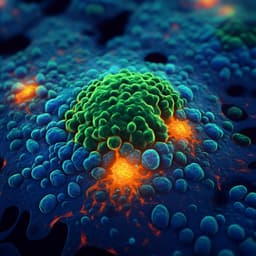
Mathematics
An exact mathematical description of computation with transient spatiotemporal dynamics in a complex-valued neural network
R. C. Budzinski, A. N. Busch, et al.
This innovative research introduces a complex-valued neural network (cv-NN) that showcases advanced spatiotemporal dynamics for sophisticated computations, such as logic gates and secure message passing. Conducted by authors from Western University and Stanford University, this study reveals that the cv-NN computations can be interpreted by biological neurons, potentially paving the way for bio-hybrid computing systems.
~3 min • Beginner • English
Introduction
Spatiotemporal dynamics provide a powerful substrate for computation in neural and physical systems, where organized waves and patterns can support prediction and transformation of inputs. Despite empirical demonstrations, it remains difficult to map how specific structures perform specific computations because rich dynamics typically arise in nonlinear systems that are hard to control and analyze. Prior work has shown computations from spatiotemporal dynamics (e.g., logic operations and speech recognition) but lacks a precise mathematical description of the input-to-output mapping along a single dynamical trajectory. This work addresses that gap by introducing a system with linear dynamics and a nonlinear readout where computations can be mathematically designed and solved exactly. The complex-valued neural network (cv-NN) uses phase delays in linear interactions to generate transient, richly structured dynamics that are then interpreted by a nonlinear decoder, enabling exact design and analysis of spatiotemporal computations.
Literature Review
The paper situates itself within research on dynamics-based computation. Prior computational and experimental studies demonstrate that spatiotemporal patterns in oscillator and reaction-diffusion systems can perform tasks from logic to prediction. Nonlinear recurrent neural networks and reservoir computing have been leveraged for complex time-series prediction and classification, but their computations are often difficult to analyze and interpret mathematically. Mean-field theories (e.g., DMFT) provide macroscopic statistics for nonlinear RNNs (autocorrelations and chaos transitions) but do not capture single-trajectory input-output computations. Chimera states (coexistence of coherence and incoherence) have been widely studied in nonlinear oscillator networks and reaction-diffusion media. Recent work has also explored linear dynamics with nonlinear readouts for computation and time-series prediction. The present study contributes an exact, closed-form description of computation in a cv-NN with linear dynamics and nonlinear readout, enabling precise design of logic operations, short-term memory, and secure message passing using transient spatiotemporal dynamics.
Methodology
Model: A complex-valued neural network (cv-NN) with N nodes. Node states x(t) ∈ C^N evolve under linear interactions with phase delays and a global intrinsic frequency. Dynamics: ẋ(t) = (i ω I + K) x(t). Here, I is the identity, i the imaginary unit, and ω = 2πf with f = 10 Hz (natural frequency; other values possible). K encodes connectivity, coupling strength, and phase-lag. In the main methods, K = ε e^{iθ} A, where ε is the coupling strength, θ the phase lag, and A the (weighted) adjacency matrix.
Network structure: Nodes are arranged on a 1D ring with periodic boundary conditions. Weighted adjacency entries: a_ij = c(α) d_ij^{-α}, for i ≠ j, with d_ij = min(|i − j|, N − |i − j|). c(α) normalizes weights so rows sum appropriately, making A symmetric and circulant. No self-connections (a_ii = 0). Hence K is also circulant.
Exact solution: x(t) = e^{tK} x(0). Define operator D_t = e^{(i ω I + K) t}, so the full state evolution from initial condition x(0) is exact and closed-form.
Input specification and design: Inputs are instantaneous multiplicative nudges applied to the cv-NN state vector. Two configurations: (1) M input nodes project to all N network nodes via a complex M×N weight matrix W; input nodes are binary on/off, producing a complex vector in C^N which is applied componentwise to x. (2) N input nodes each connect to a single network node with binary weights; each input node carries a complex state and acts on its corresponding network node, again producing a vector in C^N for componentwise application. To drive the network to a target state x at time t = τ, compute the required pre-image via the exact inverse: x(0) = D_τ^{-1} x = e^{-τK} x (assuming K is nonsingular; see numerical considerations below). Operationally, the difference between the current state and the desired pre-image is applied as an input to bump the system onto the trajectory that reaches the target at τ.
Decoder and nonlinearity: Computations are read out from phase synchronization in local network patches using the Kuramoto order parameter. For decoder unit k connected to a group of N_1 nodes, R_k[x(t)] = (1/N_1) Σ_j exp(i Arg[x_j(t)]). A Heaviside function with threshold σ is applied to R_k[x(t)] to produce a binary output o_k(t) ∈ {0,1}. Overall computation: o_k(t) = Θ_σ( R_k D_t x(0) ). This yields a closed-form expression for input-to-output mapping through the linear dynamics and nonlinear readout.
Spectral analysis: Since K is circulant, eigenvalues and eigenvectors are obtained by the Circulant Diagonalization Theorem. If K is diagonalizable, x(t) = Σ_j e^{λ_j t} c_j v_j, where λ_j are eigenvalues, v_j eigenvectors, and c_j set by x(0). The phase factor e^{iθ} rotates eigenvalues in the complex plane. For θ < π/2, the eigenvalue associated with v_1 = [1,1,...,1] has the largest real part, leading to phase synchrony. As θ approaches π/2, real parts decrease, prolonging transients and enabling rich dynamics. At θ = π/2, eigenvalues are purely imaginary (neutral coupling). For θ > π/2, Re(λ_1) becomes negative; the system cannot reach phase synchrony. Appropriate θ near π/2 creates long-lived amplitude transients with structured phase dynamics useful for computation.
Numerical considerations and feasibility: Although D_τ^{-1} exists in C^N (barring singular K), finite-precision arithmetic can yield rank-deficient behavior in practice, limiting reachable targets under some parameters (e.g., fast-synchronizing regimes). A similarity measure between target and achieved phase patterns quantifies success. Empirically, near θ ≈ π/2 and intermediate ε, arbitrary spatiotemporal patterns can be generated up to ≈10 s into the future.
Tasks implemented: (1) Logic gates, including XOR with two binary inputs X,Y and one output Z decoded from synchronization in a designated region. Interference in linear dynamics implements the XOR mapping; nonlinearity occurs only at readout. (2) Short-term memory: 1-of-8 item working memory for 3 s encoded as the spatial location of a synchronized phase cluster, decoded by 8 local decoders. Online updating is demonstrated by applying a computed input to switch stored items mid-trial. (3) Symmetric-key encryption: Define a public chimera alphabet mapping cluster positions to letters. Public parameters include network K and alphabet; the secret key is {ω, x(0)}. Bob computes ciphertext inputs I_i at chosen times t_i using D^{-1} so Alice’s cv-NN (with the secret key) exhibits the target chimera letters, while Eve (without the key) fails to produce clusters and typically observes synchronization.
Biological readout experiments: cv-NN dynamics from selected network patches are summed into aggregate signals and injected as currents into cortical neurons via intracellular electrodes. Inputs corresponding to the coherent cluster (remembered item) sum constructively and elicit spikes; inputs from asynchronous regions sum destructively and do not elicit spikes. Robustness was tested across different memory items and current scaling factors.
Key Findings
- Exact closed-form computation: The cv-NN with linear dynamics and a nonlinear readout yields an exact analytical mapping o_k(t) = Θ_σ( R_k D_t x(0) ), enabling precise design of spatiotemporal computations.
- Rich transient dynamics from linear interactions: Incorporating phase delays (θ near π/2) in a circulant, power-law-connected network creates long-lived amplitude transients with structured phase dynamics (including transient chimera states), despite linear internal dynamics.
- Logic operations: A two-input XOR gate is implemented via interference in linear dynamics, with nonlinearity applied only once at readout. The gate is robust to noise and generalizes to other logic gates.
- Short-term memory (working memory): The network stores 1-of-8 items for 3 s as the position of a phase-synchronized cluster. Online updating is demonstrated by switching the stored item mid-trial with a single locally computed input. Target spatiotemporal patterns can be generated up to about 10 s into the future for suitable parameters.
- Symmetric-key encryption: A chimera alphabet maps cluster positions to letters. Using public network structure and ciphertext {I_i, t_i} but a private key {ω, x(0)}, Alice decodes messages while an eavesdropper without the key fails to produce clusters and typically observes synchronization. Random guessing of the key does not reproduce the alphabet.
- Biological validation: Intracellular recordings show that real neurons can decode cv-NN dynamics when these are injected as currents. Inputs corresponding to coherent clusters trigger spikes; inputs from asynchronous regions do not. Results are robust across items and current scaling. Example current amplitudes are on the order of 1×10^-11 A (per figure scale).
Discussion
The study addresses the central question of how network structure and dynamics can implement specific computations via spatiotemporal patterns. By reordering the standard RNN architecture—placing linear dynamics in the recurrent core and concentrating nonlinearity at the readout—the authors derive an exact closed-form solution for the full input-to-output mapping. Phase delays tune the spectrum of the linear operator to create extended transients during which phase patterns serve as a computational reservoir. This framework clarifies, at the level of single trajectories, how designed inputs map to designed outputs through transient spatiotemporal dynamics. The work complements and extends insights from reservoir computing and nonlinear RNNs by providing exact solvability and direct construction of computations rather than training. Practically, it enables logic operations, working memory with online updates, and secure message passing. Importantly, biological neurons can act as effective nonlinear decoders of these dynamics, underscoring the relevance for bio-hybrid systems and brain–computer interfaces. The significance lies in uniting exact mathematical control with rich dynamics, offering a route to interpretable, designable computation in recurrent networks and physical substrates.
Conclusion
This work introduces a complex-valued neural network with linear recurrent dynamics and a nonlinear readout that performs sophisticated computations while being exactly solvable. The authors provide a closed-form expression for the full computation, enabling direct construction of logic gates, transient working memory with online updates, and a symmetric-key encryption scheme based on a chimera alphabet. They demonstrate that properly tuned phase delays yield rich transient spatiotemporal dynamics usable for computation and show that living neurons can decode these dynamics when used as readouts. Future directions include: scaling the decoder architecture (more units with overlap) to enhance computational performance; extending beyond cluster-based decoding to more general phase patterns; systematic exploration of parameter regimes (ε, θ, α) for controllability and robustness; and connecting these direct constructions with training methods for RNNs and physical reservoirs to broaden applicability.
Limitations
- Practical reachability: Although D_τ^{-1} exists analytically (except for singular K), finite-precision numerical implementations can be effectively rank-deficient in some regimes (e.g., fast-synchronizing), making certain targets hard to realize in practice.
- Transient window: Linear dynamics ultimately diverge or collapse; useful computations rely on a finite transient window where amplitudes remain bounded. This requires phase delays near θ ≈ π/2 and appropriate coupling strengths.
- Task scope and decoder simplicity: Demonstrations focus on cluster-based decoding (logic gates, 1-of-8 memory, simple encryption). More complex tasks may require richer decoders or multiple nonlinear stages.
- Sensitivity to parameters and initial conditions: Designed computations depend on precise ω, θ, ε, α, network topology, and x(0). Deviations (e.g., from noise or parameter drift) can reduce target matching, although robustness to some noise was shown.
- Experimental validation: Biological decoding was demonstrated in slice recordings with current injections; generalization across cell types, in vivo conditions, and long sequences remains to be tested.
Related Publications
Explore these studies to deepen your understanding of the subject.







